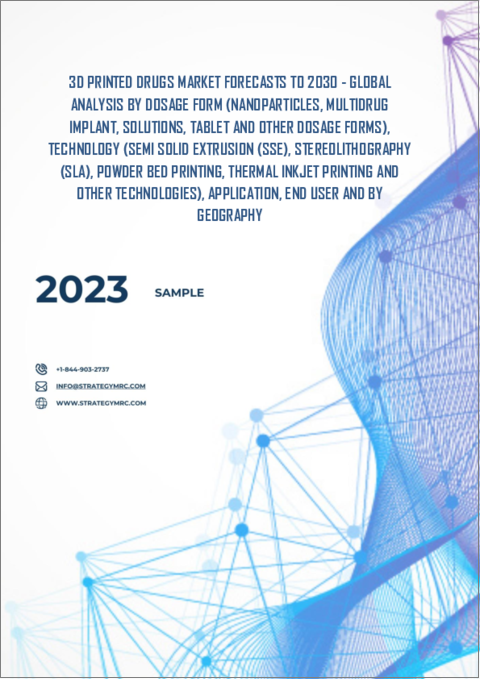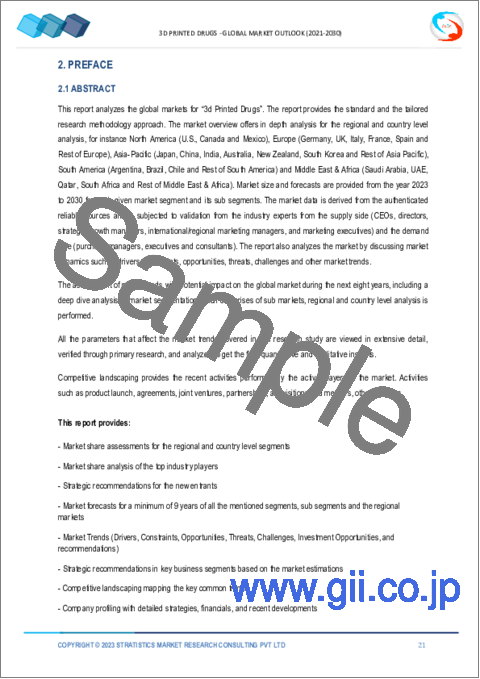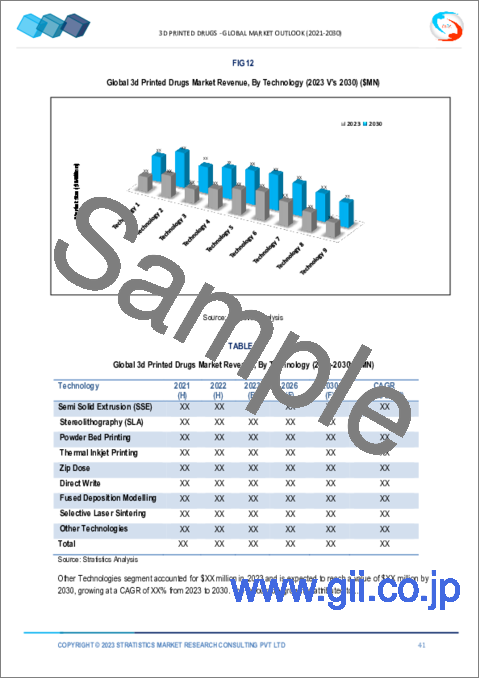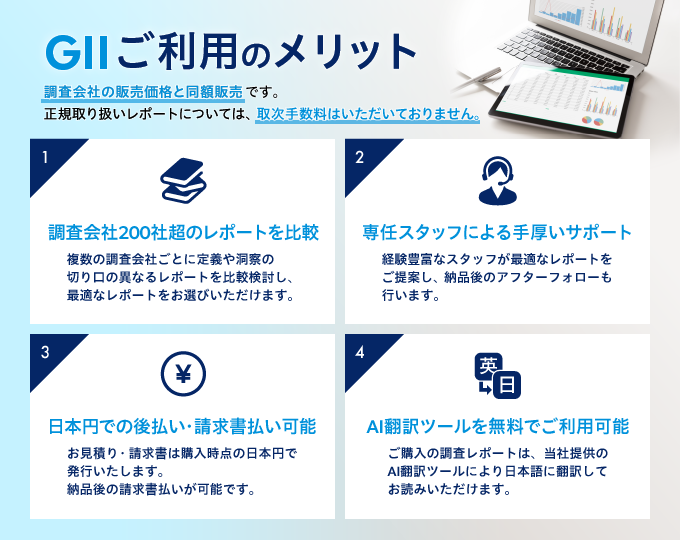|
|
市場調査レポート
商品コード
1371889
3Dプリント医薬品市場の2030年までの予測: 剤形別、技術別、用途別、エンドユーザー別、地域別の世界分析3D Printed Drugs Market Forecasts to 2030 - Global Analysis By Dosage Form, Technology (Semi Solid Extrusion, Stereolithography, Powder Bed Printing, Thermal Inkjet Printing and Other Technologies), Application, End User and By Geography |
||||||
カスタマイズ可能
|
|||||||
| 3Dプリント医薬品市場の2030年までの予測: 剤形別、技術別、用途別、エンドユーザー別、地域別の世界分析 |
|
出版日: 2023年10月01日
発行: Stratistics Market Research Consulting
ページ情報: 英文 200+ Pages
納期: 2~3営業日
|
- 全表示
- 概要
- 図表
- 目次
Stratistics MRCによると、世界の3Dプリント医薬品市場は2023年に9,909万米ドルを占め、予測期間中にCAGR 17.3%で成長し、2030年には3億279万米ドルに達すると予測されています。
3Dプリント医薬品市場は、3Dプリント技術を使用して、より安全で効率的な方法で患者ごとに特別に作られる医薬品で構成されます。これらの医薬品は、口の中で容易に分散する一体型多孔質アーキテクチャのため、完全に摂取する必要がないです。したがって、嚥下障害を頻繁に起こす患者、小児、高齢者、脳卒中、アルツハイマー病、頭頸部がん、その他の神経学的問題の影響を受けている患者はすべて、このタイプの薬剤の恩恵を受けることができます。
世界保健機関(WHO)の統計によると、2017年の世界の1人当たり医療費は1,064.741米ドルでした。世界の1人当たり医療費は、2008年の864.313米ドルから2018年には1,110.841米ドルに増加し、米国は2018年に1人当たり10,623.85米ドルの医療費に達したトップ国です。
迅速な生産とプロトタイピング、複雑な薬物送達技術
プロトタイプの製造と医薬品開発のための迅速で手頃な代替手段は3Dプリントです。射出成形や錠剤圧縮のような時間と費用のかかる従来の製造手順の必要性が軽減されます。さらに、薬剤放出の特徴を正確に制御することで、複雑なドラッグデリバリーシステムを3Dプリントで作ることができます。体内の特定部位をターゲットとし、ドラッグデリバリーを改善することで、この技術は医薬品の有効性と安全性を高めることができます。
複雑な製造プロセスと規制上のハードル
3Dプリント医薬品の規制環境はまだ発展途上であるため、こうした製品の規制上の承認を得るのは難しいです。3Dプリント医薬品の安全性、品質、有効性を保証するためには、強力な規制の枠組みと一連の基準を確立しなければならないです。しかし、医薬品製造業界で3Dプリント技術を導入するには、専門的なツールと知識が必要です。3Dプリントのためのインフラは、設置や維持に費用がかかる可能性があり、多額の投資が必要となります。
疾病の増加
例えば、肺炎は他のどの感染症よりも多くの子供が死亡しており、毎日約2,000人が亡くなっています。そのうち20万人以上が新生児です。そのため、3Dプリンターで薬を作れば、薬を飲むのが苦手な子供たちにとって、服薬がより簡単になる可能性があります。錠剤の味、色、スタイルをカスタマイズできる可能性が、これらの錠剤の最初の利点です。このような薬剤の採用が増加しているのは、小児疾患の発生率が上昇していることが影響しており、今後数年間は3Dプリント薬剤の市場が世界的に活性化すると予想されます。
3Dプリント技術のコストは高い
中小規模の製薬企業は、必要なハードウェア、ソフトウェア、材料の初期コストが高いため、3Dプリント技術の導入に課題を感じるかもしれないです。しかし、材料費が高く、製造に時間がかかるため、3Dプリント医薬品は従来の医薬品よりも単価が高くなる可能性があります。このため、3Dプリント医薬品への患者のアクセスが低下し、これらの製品に対する需要が低下する可能性があります。
COVID-19影響:
COVID-19の発生により、3Dプリントの利用が増加しています。医薬品やその他の必要な製品の製造を支援するため、先端製造業の事業担当者は多くの3Dプリンターを導入しました。さらに、COVID-19のパンデミックによる医薬品不足は、医薬品を迅速に供給するために3Dプリント技術を使用するというアイデアに製薬会社の関心を集めています。COVID-19パンデミックは市場拡大に好影響を与えると予測されています。先端製造業の事業運営は、医薬品やその他の必要不可欠な製品の生産を後押しするために、多くのプリンターを導入しています。そのため、COVID-19の流行期にはこれらの技術の利用が拡大すると予想されます。
予測期間中、神経分野が最大となる見込み
神経分野は、パーキンソン病など特定の神経疾患の有病率の上昇により、予測期間中最大のシェアを占めました。例えば、米国FDAは2015年8月にAprecia PharmaceuticalのSPRITAM(レベチラセタム)錠剤をてんかん患者の治療薬として市場で唯一承認しました。この承認により、製薬会社はこの分野への投資に注目し、市場成長を牽引しています。さらに、2022年4月に発表された論文では、ドイツとオランダの科学者グループが、3Dプリント技術を用いてパーキンソン病治療薬としてミニフローティングポリピルを作成した方法が明らかにされています。この研究では、溶融積層造形法(FDM)が利用されました。
予測期間中、サーマルインクジェットプリンティングセグメントが最も高いCAGRが見込まれる
サーマルインクジェットプリンティングセグメントは、予測期間中に最も高いCAGRを示すと推定されています。サーマルインクジェットプリンティングは、熱を利用して基板上にインクの微細な液滴を駆動し、高解像度の画像やパターンを作成する非接触印刷技術です。3Dプリント治療薬の文脈では、サーマルインクジェットプリンティング技術により、医薬品成分の正確な堆積が可能になり、指定された投与量と組成を持つオーダーメイドの医薬品の製造が可能になります。さらに、この技術は他の3Dプリントプロセスと比べて経済的であるため、さまざまな規模の製薬会社が利用しやすいです。
最大のシェアを占める地域:
慢性疾患の増加、国内の優れたヘルスケアインフラの利用可能性、研究開発への多額の投資、技術的進歩の利用拡大により、アジア太平洋地域が予想される期間で過半数を占めました。さらに、安価な医薬品や錠剤のニーズの増加、ヘルスケア産業における3Dプリントの利用拡大など、多くの要因によって市場が拡大しています。3Dプリントで製造された医薬品は、摂取が簡単でほとんどすぐに溶けることから人気を集めています。
CAGRが最も高い地域:
中国と日本が3Dプリンターによる薬剤技術を技術に統合する上でかなりの進歩を遂げたため、アジア太平洋地域は予測期間中に最も高い発展率を示すと予測されます。さらに、オーストラリアやインドのような新興国市場における臨床開発の枠組み、研究開発、ヘルスケアインフラの拡大が、アジア太平洋市場の予測期間中の有利な成長見通しを設定しています。その結果、嚥下障害率の上昇とヘルスケアインフラの拡大が市場拡大の原動力になると予測されています。
無料のカスタマイズサービス
本レポートをご購読のお客様には、以下の無料カスタマイズオプションのいずれかをご利用いただけます:
- 企業プロファイル
- 追加市場プレイヤーの包括的プロファイリング(3社まで)
- 主要企業のSWOT分析(3社まで)
- 地域セグメンテーション
- 顧客の関心に応じた主要国の市場推計・予測・CAGR(注:フィージビリティチェックによる)
- 競合ベンチマーキング
- 製品ポートフォリオ、地理的プレゼンス、戦略的提携に基づく主要企業のベンチマーキング
目次
第1章 エグゼクティブサマリー
第2章 序文
- 概要
- ステークホルダー
- 調査範囲
- 調査手法
- データマイニング
- データ分析
- データ検証
- 調査アプローチ
- 調査ソース
- 1次調査ソース
- 2次調査ソース
- 前提条件
第3章 市場動向分析
- 促進要因
- 抑制要因
- 機会
- 脅威
- 技術分析
- 用途分析
- エンドユーザー分析
- 新興市場
- 新型コロナウイルス感染症(COVID-19)の影響
第4章 ポーターのファイブフォース分析
- 供給企業の交渉力
- 買い手の交渉力
- 代替品の脅威
- 新規参入業者の脅威
- 競争企業間の敵対関係
第5章 世界の3Dプリント医薬品市場:剤形別
- ナノ粒子
- 多剤併用インプラント
- ソリューション
- タブレット
- その他の剤形
第6章 世界の3Dプリント医薬品市場:技術別
- 半固体押出(SSE)
- 光造形(SLA)
- パウダーベッド印刷
- サーマルインクジェット印刷
- ジップドーズ
- 直接書き込み
- 溶融堆積モデリング
- 選択的レーザー焼結
- その他の技術
第7章 世界の3Dプリント医薬品市場:用途別
- 歯科
- 神経内科
- 整形外科
- 子供用
- お年寄り用
- その他の用途
第8章 世界の3Dプリント医薬品市場:エンドユーザー別
- 研究
- 病院とクリニック
- その他のエンドユーザー
第9章 世界の3Dプリント医薬品市場:地域別
- 北米
- 米国
- カナダ
- メキシコ
- 欧州
- ドイツ
- 英国
- イタリア
- フランス
- スペイン
- その他欧州
- アジア太平洋地域
- 日本
- 中国
- インド
- オーストラリア
- ニュージーランド
- 韓国
- その他アジア太平洋地域
- 南米
- アルゼンチン
- ブラジル
- チリ
- その他南米
- 中東とアフリカ
- サウジアラビア
- アラブ首長国連邦
- カタール
- 南アフリカ
- その他中東とアフリカ
第10章 主な発展
- 契約、パートナーシップ、コラボレーション、合弁事業
- 買収と合併
- 新製品の発売
- 事業拡大
- その他の主要戦略
第11章 企業プロファイル
- Affinity Therapeutics
- Aprecia Pharmaceuticals LLC
- Astrazeneca
- Bioduro
- Cycle Pharmaceuticals
- Extend Biosciences
- Fabrx Ltd
- Glaxosmithkline PLC
- Hewlett Packard Caribe
- Osmotica Pharmaceuticals
List of Tables
- Table 1 Global 3D Printed Drugs Market Outlook, By Region (2021-2030) ($MN)
- Table 2 Global 3D Printed Drugs Market Outlook, By Dosage Form (2021-2030) ($MN)
- Table 3 Global 3D Printed Drugs Market Outlook, By Nanoparticles (2021-2030) ($MN)
- Table 4 Global 3D Printed Drugs Market Outlook, By Multidrug Implant (2021-2030) ($MN)
- Table 5 Global 3D Printed Drugs Market Outlook, By Solutions (2021-2030) ($MN)
- Table 6 Global 3D Printed Drugs Market Outlook, By Tablet (2021-2030) ($MN)
- Table 7 Global 3D Printed Drugs Market Outlook, By Other Dosage Forms (2021-2030) ($MN)
- Table 8 Global 3D Printed Drugs Market Outlook, By Technology (2021-2030) ($MN)
- Table 9 Global 3D Printed Drugs Market Outlook, By Semi Solid Extrusion (SSE) (2021-2030) ($MN)
- Table 10 Global 3D Printed Drugs Market Outlook, By Stereolithography (SLA) (2021-2030) ($MN)
- Table 11 Global 3D Printed Drugs Market Outlook, By Powder Bed Printing (2021-2030) ($MN)
- Table 12 Global 3D Printed Drugs Market Outlook, By Thermal Inkjet Printing (2021-2030) ($MN)
- Table 13 Global 3D Printed Drugs Market Outlook, By Zip Dose (2021-2030) ($MN)
- Table 14 Global 3D Printed Drugs Market Outlook, By Direct Write (2021-2030) ($MN)
- Table 15 Global 3D Printed Drugs Market Outlook, By Fused Deposition Modelling (2021-2030) ($MN)
- Table 16 Global 3D Printed Drugs Market Outlook, By Selective Laser Sintering (2021-2030) ($MN)
- Table 17 Global 3D Printed Drugs Market Outlook, By Other Technologies (2021-2030) ($MN)
- Table 18 Global 3D Printed Drugs Market Outlook, By Application (2021-2030) ($MN)
- Table 19 Global 3D Printed Drugs Market Outlook, By Dental (2021-2030) ($MN)
- Table 20 Global 3D Printed Drugs Market Outlook, By Neurology (2021-2030) ($MN)
- Table 21 Global 3D Printed Drugs Market Outlook, By Orthopedic (2021-2030) ($MN)
- Table 22 Global 3D Printed Drugs Market Outlook, By Children (2021-2030) ($MN)
- Table 23 Global 3D Printed Drugs Market Outlook, By Elderly (2021-2030) ($MN)
- Table 24 Global 3D Printed Drugs Market Outlook, By Other Applications (2021-2030) ($MN)
- Table 25 Global 3D Printed Drugs Market Outlook, By End User (2021-2030) ($MN)
- Table 26 Global 3D Printed Drugs Market Outlook, By Research Laboratories (2021-2030) ($MN)
- Table 27 Global 3D Printed Drugs Market Outlook, By Hospitals & Clinics (2021-2030) ($MN)
- Table 28 Global 3D Printed Drugs Market Outlook, By Other End Users (2021-2030) ($MN)
Note: Tables for North America, Europe, APAC, South America, and Middle East & Africa Regions are also represented in the same manner as above.
According to Stratistics MRC, the Global 3D Printed Drugs Market is accounted for $99.09 million in 2023 and is expected to reach $302.79 million by 2030 growing at a CAGR of 17.3% during the forecast period. The market for 3D-printed drugs consists of pharmaceuticals that are made specifically for each patient in a safer and more efficient manner using 3D printing technology. These medications do not have to be ingested completely because of their unitary porous architecture, which easily disperses in the mouth. Therefore, patients who frequently have swallowing issues, children, the elderly, and those suffering from the effects of stroke, Alzheimer's disease, head and neck cancers, and other neurological problems can all benefit from this type of drug.
According to the statistics by the World Health Organization, the global per capita healthcare expenditure amounted to USD 1,064.741 in the year 2017. The worldwide healthcare expenditure per person grew from USD 864.313 in 2008 to USD 1,110.841 in 2018, where the U.S. is the top country that amounted to healthcare expenditure of USD 10, 623.85 per capita in 2018.
Market Dynamics:
Driver:
Rapid production and prototyping and complex medication delivery techniques
A rapid and affordable alternative for producing prototypes and developing pharmaceuticals is 3D printing. It reduces the need for time- and money-consuming traditional manufacturing procedures like injection molding and tablet compression. Additionally, with precise control over medication release features, complex drug delivery systems can be made through 3D printing. By targeting particular regions of the body and improving drug delivery, this technique can increase the efficacy and safety of medications.
Restraint:
Complex manufacturing processes and regulatory hurdles
Obtaining regulatory approval for these products is difficult, as the regulatory environment for 3D-printed drugs is still developing. A strong regulatory framework and set of criteria must be established in order to guarantee the safety, quality, and effectiveness of 3D-printed drugs. However, specialized tools and knowledge are needed to implement 3D printing technology in the pharmaceutical production industry. The infrastructure for 3D printing can be expensive to set up and maintain, necessitating substantial investments.
Opportunity:
Rising disease prevalence
For instance, pneumonia kills more children than any other infectious disease and causes about 2,000 deaths each day. Newborns make up more than 200,000 of them. Therefore, due to 3D-printed medications, taking medication could become a lot simpler for kids who are averse to doing so. The possibility of customizing the tablet's taste, color, and style is the first advantage of these tablets. The rising adoption of these medications is being influenced by the rising incidence of pediatric disorders, which is expected to fuel the market for 3D-printed drugs globally over the next few years.
Threat:
The cost of 3D printing technology is high
Small and medium-sized pharmaceutical enterprises might find it challenging to embrace 3D printing technology due to the high initial cost of the necessary hardware, software, and materials. However, due to the high cost of materials and the period of time needed for production, 3D-printed pharmaceuticals may have higher prices per unit than conventional drugs. This may lower patient access to 3D-printed medications and lower demand for these products.
COVID-19 Impact:
The use of 3D printing has increased as a result of the COVID-19 outbreak. To assist with the creation of medicines and other necessary products, the operational individuals in the advanced manufacturing industry have introduced a number of 3D printers. Additionally, the COVID-19 pandemic's drug shortages have drawn pharmaceutical companies' attention to the idea of using 3D printing technology to supply medications rapidly. The COVID-19 pandemic is projected to have a favorable effect on market expansion. The operation of businesses in the advanced manufacturing sector has introduced a number of printers to aid in boosting the production of medicines and other essential products. Therefore, it is anticipated that the use of these technologies will grow during the COVID-19 pandemic.
The neurology segment is expected to be the largest during the forecast period
Neurology segment commanded the largest share over the projection period, due to the rise in prevalence of certain neurological conditions, such as Parkinson's disease. For instance, The U.S. FDA approved Aprecia Pharmaceutical's SPRITAM (levetiracetam) tablets in August 2015 as the only approved drug on the market for the treatment of people with epilepsy. This approval has attracted pharmaceutical companies' attention to invest in this segment, driving market growth. Additionally, in an article published in April 2022, a group of scientists from Germany and the Netherlands revealed how they created the Mini-Floating Polypill as a Parkinson's disease treatment using 3D printing technology. This study made use of fused deposition modeling (FDM).
The thermal inkjet printing segment is expected to have the highest CAGR during the forecast period
Thermal Inkjet Printing segment is estimated to witness the highest CAGR over the extrapolated period. Thermal Inkjet Printing is a non-contact printing technology that utilizes heat to drive microscopic droplets of ink onto a substrate, creating high-resolution pictures or patterns. In the context of 3D printed therapeutics, thermal inkjet printing technology allows for the accurate deposition of pharmaceutical ingredients, enabling the fabrication of tailored medications with specified dosages and compositions. Moreover, the technology is reasonably economical compared to other 3D printing processes, making it accessible to pharmaceutical companies of varying sizes.
Region with largest share:
Due to an increased prevalence of chronic diseases, the availability of an outstanding domestic healthcare infrastructure, significant investment in R&D, and the region's expanding utilization of technological advancements, the Asia Pacific region dominated with a majority over the anticipated period. Moreover, the market is expanding due to a number of factors, including the increased need for less expensive medications or tablets and the expanding use of 3D printing in the healthcare industry. Pharmaceuticals produced through 3D printing are gaining popularity as they are simple to consume and almost immediately dissolve.
Region with highest CAGR:
Due to considerable advancements made by China and Japan in the integration of 3D-printed drug techniques into technology, the Asia Pacific is predicted to have the highest rate of development over the projected period. Furthermore, the expansion of clinical development frameworks, R&D, and healthcare infrastructure in developing nations like Australia and India is setting the Asia Pacific market for lucrative growth prospects over the course of the projection period. As a result, rising dysphagia rates and expanding healthcare infrastructure are predicted to drive market expansion.
Key players in the market:
Some of the key players in 3D Printed Drugs market include: Affinity Therapeutics, Aprecia Pharmaceuticals LLC , Astrazeneca, Bioduro, Cycle Pharmaceuticals, Extend Biosciences, Fabrx Ltd, Glaxosmithkline PLC, Hewlett Packard Caribe and Osmotica Pharmaceuticals.
Key Developments:
In October 2022, Cycle Pharmaceuticals Limited (Cycle) announced the launch of JAVYGTOR (sapropterin dihydrochloride) Tablets for Oral Use and Powder for Oral Solution, as a treatment option for patients with Phenylketonuria (PKU), approved by the US Food and Drug Administration (FDA). The launch of JAVYGTOR continues an established partnership between Cycle and Dr Reddy's Laboratories Ltd, in which the two companies are committed to providing affordable medicines to patients with rare diseases, complemented by the support these patients need.
Dosage Forms Covered:
- Nanoparticles
- Multidrug Implant
- Solutions
- Tablet
- Other Dosage Forms
Technologies Covered:
- Semi Solid Extrusion (SSE)
- Stereolithography (SLA)
- Powder Bed Printing
- Thermal Inkjet Printing
- Zip Dose
- Direct Write
- Fused Deposition Modelling
- Selective Laser Sintering
- Other Technologies
Applications Covered:
- Dental
- Neurology
- Orthopedic
- Children
- Elderly
- Other Applications
End Users Covered:
- Research Laboratories
- Hospitals & Clinics
- Other End Users
Regions Covered:
- North America
- US
- Canada
- Mexico
- Europe
- Germany
- UK
- Italy
- France
- Spain
- Rest of Europe
- Asia Pacific
- Japan
- China
- India
- Australia
- New Zealand
- South Korea
- Rest of Asia Pacific
- South America
- Argentina
- Brazil
- Chile
- Rest of South America
- Middle East & Africa
- Saudi Arabia
- UAE
- Qatar
- South Africa
- Rest of Middle East & Africa
What our report offers:
- Market share assessments for the regional and country-level segments
- Strategic recommendations for the new entrants
- Covers Market data for the years 2021, 2022, 2023, 2026, and 2030
- Market Trends (Drivers, Constraints, Opportunities, Threats, Challenges, Investment Opportunities, and recommendations)
- Strategic recommendations in key business segments based on the market estimations
- Competitive landscaping mapping the key common trends
- Company profiling with detailed strategies, financials, and recent developments
- Supply chain trends mapping the latest technological advancements
Free Customization Offerings:
All the customers of this report will be entitled to receive one of the following free customization options:
- Company Profiling
- Comprehensive profiling of additional market players (up to 3)
- SWOT Analysis of key players (up to 3)
- Regional Segmentation
- Market estimations, Forecasts and CAGR of any prominent country as per the client's interest (Note: Depends on feasibility check)
- Competitive Benchmarking
- Benchmarking of key players based on product portfolio, geographical presence, and strategic alliances
Table of Contents
1 Executive Summary
2 Preface
- 2.1 Abstract
- 2.2 Stake Holders
- 2.3 Research Scope
- 2.4 Research Methodology
- 2.4.1 Data Mining
- 2.4.2 Data Analysis
- 2.4.3 Data Validation
- 2.4.4 Research Approach
- 2.5 Research Sources
- 2.5.1 Primary Research Sources
- 2.5.2 Secondary Research Sources
- 2.5.3 Assumptions
3 Market Trend Analysis
- 3.1 Introduction
- 3.2 Drivers
- 3.3 Restraints
- 3.4 Opportunities
- 3.5 Threats
- 3.6 Technology Analysis
- 3.7 Application Analysis
- 3.8 End User Analysis
- 3.9 Emerging Markets
- 3.10 Impact of Covid-19
4 Porters Five Force Analysis
- 4.1 Bargaining power of suppliers
- 4.2 Bargaining power of buyers
- 4.3 Threat of substitutes
- 4.4 Threat of new entrants
- 4.5 Competitive rivalry
5 Global 3D Printed Drugs Market, By Dosage Form
- 5.1 Introduction
- 5.2 Nanoparticles
- 5.3 Multidrug Implant
- 5.4 Solutions
- 5.5 Tablet
- 5.6 Other Dosage Forms
6 Global 3D Printed Drugs Market, By Technology
- 6.1 Introduction
- 6.2 Semi Solid Extrusion (SSE)
- 6.3 Stereolithography (SLA)
- 6.4 Powder Bed Printing
- 6.5 Thermal Inkjet Printing
- 6.6 Zip Dose
- 6.7 Direct Write
- 6.8 Fused Deposition Modelling
- 6.9 Selective Laser Sintering
- 6.10 Other Technologies
7 Global 3D Printed Drugs Market, By Application
- 7.1 Introduction
- 7.2 Dental
- 7.3 Neurology
- 7.4 Orthopedic
- 7.5 Children
- 7.6 Elderly
- 7.7 Other Applications
8 Global 3D Printed Drugs Market, By End User
- 8.1 Introduction
- 8.2 Research Laboratories
- 8.3 Hospitals & Clinics
- 8.4 Other End Users
9 Global 3D Printed Drugs Market, By Geography
- 9.1 Introduction
- 9.2 North America
- 9.2.1 US
- 9.2.2 Canada
- 9.2.3 Mexico
- 9.3 Europe
- 9.3.1 Germany
- 9.3.2 UK
- 9.3.3 Italy
- 9.3.4 France
- 9.3.5 Spain
- 9.3.6 Rest of Europe
- 9.4 Asia Pacific
- 9.4.1 Japan
- 9.4.2 China
- 9.4.3 India
- 9.4.4 Australia
- 9.4.5 New Zealand
- 9.4.6 South Korea
- 9.4.7 Rest of Asia Pacific
- 9.5 South America
- 9.5.1 Argentina
- 9.5.2 Brazil
- 9.5.3 Chile
- 9.5.4 Rest of South America
- 9.6 Middle East & Africa
- 9.6.1 Saudi Arabia
- 9.6.2 UAE
- 9.6.3 Qatar
- 9.6.4 South Africa
- 9.6.5 Rest of Middle East & Africa
10 Key Developments
- 10.1 Agreements, Partnerships, Collaborations and Joint Ventures
- 10.2 Acquisitions & Mergers
- 10.3 New Product Launch
- 10.4 Expansions
- 10.5 Other Key Strategies
11 Company Profiling
- 11.1 Affinity Therapeutics
- 11.2 Aprecia Pharmaceuticals LLC
- 11.3 Astrazeneca
- 11.4 Bioduro
- 11.5 Cycle Pharmaceuticals
- 11.6 Extend Biosciences
- 11.7 Fabrx Ltd
- 11.8 Glaxosmithkline PLC
- 11.9 Hewlett Packard Caribe
- 11.10 Osmotica Pharmaceuticals






